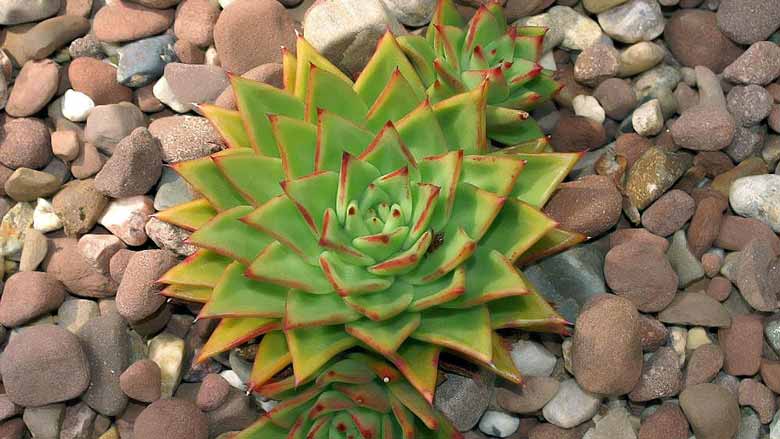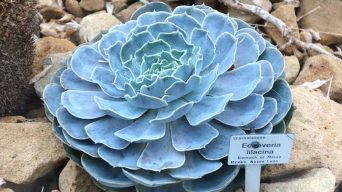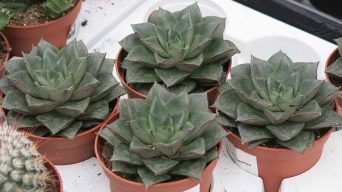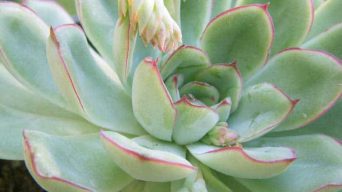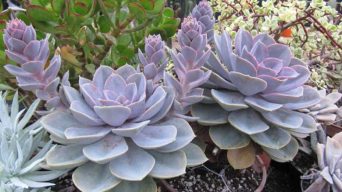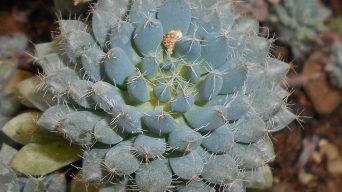Echeveria Agavoides is a popular succulent plant that is often used as a houseplant.
The Echeverias have thick, fleshy leaves and grow as rosettes of 8 inches in diameter.
They can be propagated by stem cuttings, leaf cuttings, or offsets, and it’s worth knowing how to care for the plant properly.
In this article, we will discuss what you need to know about Echeveria Agavoides Care and Propagation.
About the Echeveria Agavoides (Molded Wax Agave)
Echeveria Agavoides is a succulent plant that belongs to the Crassulaceae family.
It originates from the deserts of Mexico and has a rosette-shaped form. Its leaves have red edges, by which it is commonly known by the nickname “Echeveria Lipstick”.
This Echeveria species is also known by the name “Molded Wax Agave” due to its similarity to the Agave plant.
This succulent grows up to 8 inches in height, making it an excellent choice for small spaces.
How To Care for Echeveria Agavoides ‘Lipstick Echeveria’
Sun Exposure & Light Requirements
A succulent in the Echeveria genus, like Echeverias agavoides, needs full sun to partial shade.
They need at least six hours of indirect sunlight per day to thrive. Morning or late afternoon sunshine is perfect for these plants.
They do not like too much direct sunlight, as it will likely cause sunburn. In areas with hot summers and intense sun exposure, Echeveria agavoides may need some shade.
When growing Echeveria indoors, they need well-lit windowsills and a lot of natural light. A north-facing window is best, but west or east-facing will work as well.
Echeveria Agavoides succulents should not be placed in full shade because they require enough sunlight for their photosynthesis process.
Watering Echeveria Agavoides
Echeveria Agavoides is a succulent plant, which means it has water storing capabilities. Echeverias are sensitive to overwatering and under-watered, so learning how they should be appropriately watered is essential.
Echeverias need water when the soil begins to dry.
To test for this, lightly squeeze the top ½ inch of potting mix, and if it sticks together, then you should give your Echeveria a quick drink.
If there is no resistance in the potting mix with gentle pressure, then do not water your plant just yet.
Echeverias should be watered until the water begins to run out of the bottom.
It is also important that Echeveria plants are not overwatered! Ensure there is drainage at the bottom, or else this will damage roots, killing an Echeveria plant.
Soil
Echeveria Agavoides prefers a soil mix that provides good drainage and aeration.
It can be planted in a cactus potting mix or any other well-draining succulent soil blend of your preference, like 50% peat moss and 50% perlite (or an equivalent).
Try to avoid mixes that contain fertilizer, as this will cause the plant roots to rot away.
Ensure the container has at least one inch deep of appropriate soil to accommodate the roots before planting your succulents in it.
Echeveria plants like a well-draining soil with some organic material. This will decompose in the ground and give your plant nutrients.
Temperature and Humidity
Echeveria Agavoides plants do well in a range of temperature and humidity.
They can thrive when it is 55-85 degrees Fahrenheit with up to 80% relative humidity.
The plant will like the warmer temperatures, but not too much, as they may get scorched or dried out if there isn’t enough water.
As for the humidity level, on average, it should be around 70%. The level can vary depending on where the plant is located.
If it doesn’t get enough humidity in an enclosed area, you should mist it a few times per day to keep up with its needs.
Fertilizing
The Echeveria Agavoides does not need to be fertilized often. If you find that the succulent is starting to wilt or has yellow leaves, it may be time for a feeding.
When there are no signs of plants wilting or dying even after months without fertilizing them, they do not need any fertilizer and will only have enough nutrients from rainwater alone.
If you think you need to fertilize your plants, you can use a slow-release fertilizer or a liquid fertilizer diluted to half strength.
Liquid fertilizer can be applied by pouring it on the soil, applying it directly to a dry stem before watering, or using a mister.
Slow-release fertilizers are best for Echeveria Agavoides plants that live in clay pots. They will leach more slowly into the potting mix and not bring up too much salt from container soils with high natural sodium content.
Potting and Repotting
Echeveria plants are fast growers and should be repotted every year.
Generally speaking, the plant will need to be pot up when it has outgrown its current container or is nearing touching the edges of its container.
It can also grow in a larger pot size as long as there is enough soil for root growth and drainage purposes.
You may want to consider purchasing an oversized planter if you do not have a space large enough for this particular Echeveria succulent plant after it matures over time.
If you are reporting and transferring the plant, wait until it is dry before doing so. Planting or potting an Echeveria Agavoides when it’s wet will only cause rot to set in more quickly.
Pruning
Echeveria agavoides don’t need to be pruned at all. The only thing you need to do is to remove the old leaves that will eventually wither away.
When removing old leaves, be careful not to pull too hard, as this can lead to damaging the plant.
The leaves will eventually wither away, and you should remove them carefully so that they do not leave any marks on the stem of your Echeveria agavoides.
Pests and Diseases
Echeveria Agavoides succulent plants are susceptible to scale and mealybugs.
These pests can usually be removed by simply washing them off with water or a dilute soap solution, but they may reappear over time.
If the plant becomes infected, discarding the pest and any egg sacs laid in its soil is best. This will prevent reinfestation in the coming months.
The Echeveria Agavoides succulent plant also suffers from gray mold, which appears as fuzzy patches on leaves.
For most plants afflicted with this fungus, the problem should clear up naturally if you remove dead foliage at once when symptoms first appear.
However, plants with weak immune systems or those grown in humid environments are likely to succumb after the first round of infection.
For such plants, use a fungicide to prevent the spread of further contamination.
How To Propagate Echeveria Agavoides
The Echeveria agavoides can be propagated by stem cuttings, leaf cuttings, and offsets.
Leaf Cuttings
Leaf cuttings are perhaps the most common method of propagating echeveria agavoides plants. It is recommended to take a healthy leaf. Still, they can also be taken from the plant when it sheds.
- Use a sharp blade or kitchen shears to cut off leaf edges and ensure no large pieces of stem are on the bottom side of each piece.
- Let the leaf cutting callous over for several days to form a natural seal before potting.
- Place each cutting in a succulent potting mix with some water until roots form (usually about two weeks).
- Once the Echeveria agavoides leaf cuttings have rooted, carefully remove them from the potting mix and place them in a light location with plenty of sun.
- Keep soil moist but not wet. If they are too dry, root rot will occur before they can establish themselves.
The best time to take Echeveria agavoides leaves for propagation is during summer or fall when it’s actively growing.
This ensures that more roots will form. At the same time, there is still enough sunlight available for growth to happen quickly.
Stem Cuttings
Echeveria Agavoides stem cuttings are an easy way to propagate and grow this succulent plant.
- Take a cutting that is at least four inches long.
- Trim the cutting so that it has a flat surface and cut off any leaves on top or below this area.
- Place in a container with sand, gravel, cactus potting soil mix (a succulent blend), or other porous material such as perlite.
- Keep moist but not wet for two weeks, then move outside to enjoy full sunlight during warmer months.
- Pot the plant in a container when it is 12 inches tall.
- Water as needed to keep the soil moist.
Offsets
Offsets propagating are the most common way to propagate Echeveria agavoides succulent plants.
Echeverias produce small offsets at the base of their rosette.
The offsets can be pulled off from the mother plant and then potted in a well-draining soil mix.
Echeverias will produce more offsets if they are grown under brighter light for several hours per day or have a long growing period (14 weeks).
Offsets should be transplanted when they reach about three inches tall to avoid them becoming root-bound.
Is the Echeveria Agavoides Toxic?
The Echeveria agavoides plant is not known to be toxic to humans or animals.
Some people may be allergic to the sap in this plant as it is easily transferred to human tissue.
Plant sap can cause an allergic reaction in people with sensitive skin, so be sure not to touch your face or eyes after handling them without washing them well first.
If you are unsure about any potential allergies, it’s always best to wear gloves when gardening and thoroughly wash your hands before eating.
Final Thoughts
Growing succulents is a lot of fun and can be relatively easy.
But it may take some time and patience for beginners.
If you are an experienced gardener, succulents can be a great addition to your collection as they require little maintenance and look beautiful year-round!

